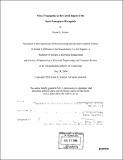Sferic propagation in the cutoff region of the earth-ionosphere waveguide
Author(s)
Surana, Kunal K. (Kunal Krishna), 1979-
DownloadFull printable version (14.29Mb)
Other Contributors
Massachusetts Institute of Technology. Dept. of Electrical Engineering and Computer Science.
Advisor
Earle Williams.
Terms of use
Metadata
Show full item recordAbstract
The waveguide cutoff phenomenon provides information about the height of a waveguide. This cutoff for the earth-ionosphere waveguide is illuminated by lightning sferics and is used to monitor the change in ionosphere height through the day-night boundary. The observed ionospheric heights are found to be dependent on the three kinds of source-receiver paths: daytime, nighttime and mixed. Accurate locations for individual events are obtained from the National Lightning Detection Network (NLDN) to enable the analysis. Tweek sferics, which asymptote towards the transverse resonance frequency of the waveguide, predominate in the night path giving the most precise information about ionospheric heights. Weak dispersion and steep transitions in one-dimensional spectra provide information about daytime heights. Propagation over mixed paths reveals both daytime and nighttime signatures. Nighttime observations are also compared against theoretical predictions (Porrat et al, 2001). Agreement is best for large peak current events ( > 100) kA). Some indication of a residual daytime effect in a nighttime ionosphere is also observed.
Description
Thesis (M. Eng. and S.B.)--Massachusetts Institute of Technology, Dept. of Electrical Engineering and Computer Science, 2004. Includes bibliographical references (leaves 93-96).
Date issued
2004Department
Massachusetts Institute of Technology. Department of Electrical Engineering and Computer SciencePublisher
Massachusetts Institute of Technology
Keywords
Electrical Engineering and Computer Science.